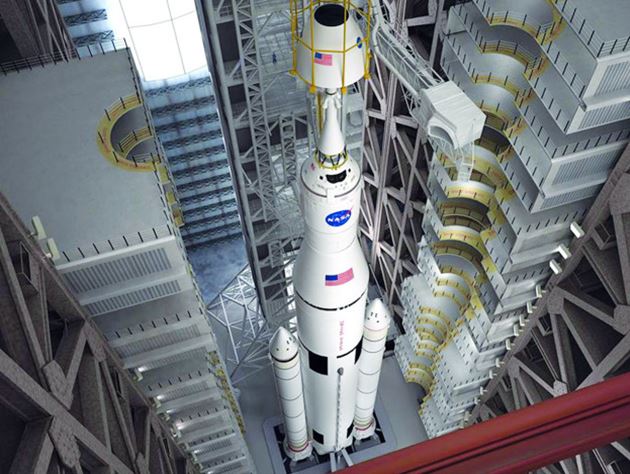 NASA has put plans in motion to build the largest and most powerful rocket the world has ever seen. It sounds like the beginning of a new Bond film, but the agency said it’s moving forward with a new Space Launch System (SLS)—possibly in two size configurations—capable of lifting up to 286,000 pounds. The first manned launch is tentatively scheduled for 2021, which will see the SLS propel a new spacecraft, known as Orion, to either a nearby asteroid or the moon. If successful, NASA’s SLS could even be used for a Mars mission.
NASA has put plans in motion to build the largest and most powerful rocket the world has ever seen. It sounds like the beginning of a new Bond film, but the agency said it’s moving forward with a new Space Launch System (SLS)—possibly in two size configurations—capable of lifting up to 286,000 pounds. The first manned launch is tentatively scheduled for 2021, which will see the SLS propel a new spacecraft, known as Orion, to either a nearby asteroid or the moon. If successful, NASA’s SLS could even be used for a Mars mission.
Similar to the Saturn V rocket used for previous Apollo missions, NASA’s SLS rocket could weigh as much as 143 tons, and be able to lift over 286,000 pounds. On a slightly less immense scale, NASA is also envisioning a 77 ton, 154,000 pound SLS; both would be capable of shuttling astronauts, along with copious amounts of supplies in addition to the Orion spacecraft. NASA’s larger configuration is expected to create 9.2 million pounds of thrust, about 20-percent more than a Saturn V.
When built, the larger of the two SLS configurations will be as tall as a 38-story building—about as tall as a hotel in Vegas. In order to propel such an enormous object, the SLS will rely on two solid rocket boosters, along with a 200-foot-tall core stage, which will be filled with liquid hydrogen and oxygen to fuel the four RS-25 engines. NASA said that its RS-25 rocket engine has seen 100-percent mission success during 135 space shuttle missions. However, in order to use them for a larger rocket, the engines will need to be modified, and therefore tested, which will take place this July.
Meanwhile, NASA’s Orion spacecraft has been in development since 2005, and is designed as a multi-purpose crew vehicle; the craft itself is about 26 feet tall, capable of carrying a crew of four members. For context, SpaceX’s Dragon spacecraft is capable of carrying seven crew members, though it was only intended for launch to NASA’s International Space Station. Orion will include features such as a Launch Abort System, Spacecraft Adapter, Instrument Unit, Crew Module and more. Once attached to the SLS, Orion will sit atop the rocket like a hat.
As of now, NASA says it has plans to test out an unmanned Orion spacecraft later this year, with an expected journey of 3,600 miles, and fifteen times farther from Earth than the ISS. It will then return to Earth, where scientists expect the spacecraft could reach an incredible 4,000 miles-per-hour as it burns through the planet’s atmosphere.
[ Original article here ]
